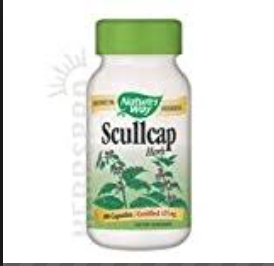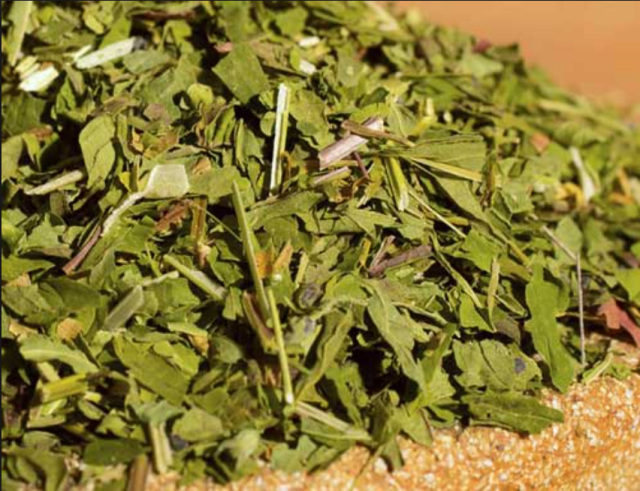
Skullcap Plant
General Information:
The Blue Skullcap is native across North America, hardiness zones 6-9. Other common names for the Skullcap are mad dog skullcap, or side-flowering skullcap. The plant is a perennial that can be found growing near marshes and meadows. Skullcap grows to be around two feet tall, it’s leaves are about 2.5 in long and distinctly scalloped. As part of the Lamiaceae (mint) family, Skullcap has a distinctive square stem. The flowers grow in pairs, shaped like small irregular trumpets with small hairs covering.

Trumpet Shaped Flower

Scalloped Leaf
Traditional Uses
Skullcap is known for it’s relaxing effects, it is used as a sedative for nervousness and anxiety. Skullcap should be collected in the summer while it is blooming, then used fresh as a tincture, or dried for later uses in tea. The powdered herb should be added to boiling water, and allowed to steep for 10 minutes, then administered several times per day. The tea or tincture is often used to treat epilepsy, insomnia, hysteria, anxiety, delirium tremors, nervous headaches and neuralgia. Some use skullcap as an alternative treatment for ADD and other nerve disorders.
Skullcap was traditionally used by Native Americans as an emmenagogue to induce menstruation, to treat rabies or schizophrenia, and to induce visions. Sometimes, the plant was also used as a ceremonial plant to introduce young girls to womanhood. This plant was also used in Chinese medicines to act as a drying agent, curing dampness in the stomach and intestines. Some important chemical components of Skullcap include: scutellarin, catalpa, baicalin, wogonin, lignans, resins, other oils, and tannins.
Most sources note that Skullcap does not seem to have any adverse side effects. Tea is taken in small doses, and should not be taken while pregnant. Skullcap may exaggerate the effects of other medicines that cause drowsiness.

Skullcap can be found in pill form

Dried Skullcap, used for tea
Current Research:
There is extensive research concerning one of the main chemical components of the plant, biacalin. Biacalin is a flavenoid found throughout the entire plant, that can be extracted into a pill or prescribed to a patient as tea. Research on biacalin and its functions varies from its use as an antidiabetic, a therapeutic medicine against Alzheimer’s and Parkinson’s disease, a treatment to pancreatic cancer, and many others. Most research concerning biacalin references its effectiveness as an inhibitory agent. As an antidiabetic, biacalin inhibits alpha-glucosidase, a crucial player in furthering diabetes. As a treatment to Alzheimer’s and Parkinson’s disease, biacalin prevents the loss of neurons and synaptic functions in the brain by inhibiting the accumulation of prions, this treatment is aided by prescriptions of Skullcap tea in addition to biacalin alone. Biacalin also inhibits ferroptosis, an important aspect that allows for cancer cells to develop in the pancreas, in addition to other tissue damage.
Some studies also looked at Skullcap holistically. One study conducted an experiment among healthy participants with mild anxiety. Generally, those taking Skullcap tea three times per day for an extended period of time experienced lower anxiety scores as compared to the placebo group. The experimental group also experienced lower anxiety levels as compared to their baseline data. An article researching plant-based alternative medicines for anxiety disorder included Skullcap as a potentially useful treatment.
Sources:
https://plants.usda.gov/core/profile?symbol=scla2
https://www.minnesotawildflowers.info/flower/mad-dog-skullcap
https://altnature.com/gallery/skullcap.htm
https://www.ncbi.nlm.nih.gov/pubmed/22574444
https://www.ncbi.nlm.nih.gov/pubmed/22363300
https://www.ncbi.nlm.nih.gov/pubmed/23878109
https://www.ncbi.nlm.nih.gov/pubmed/23653088
Picture Sources:
https://gobotany.newenglandwild.org/species/scutellaria/lateriflora/
http://7song.com/blog/2012/02/the-skullcaps-a-scutellaria-monograph/
http://www.gaiaherbs.com/products/ingredient/367/American-Skullcap
ttp://www.rjwhelan.co.nz/herbs%20A-Z/herb%20images/skullcap_dried.jpg
Page created by Jenny Walz
